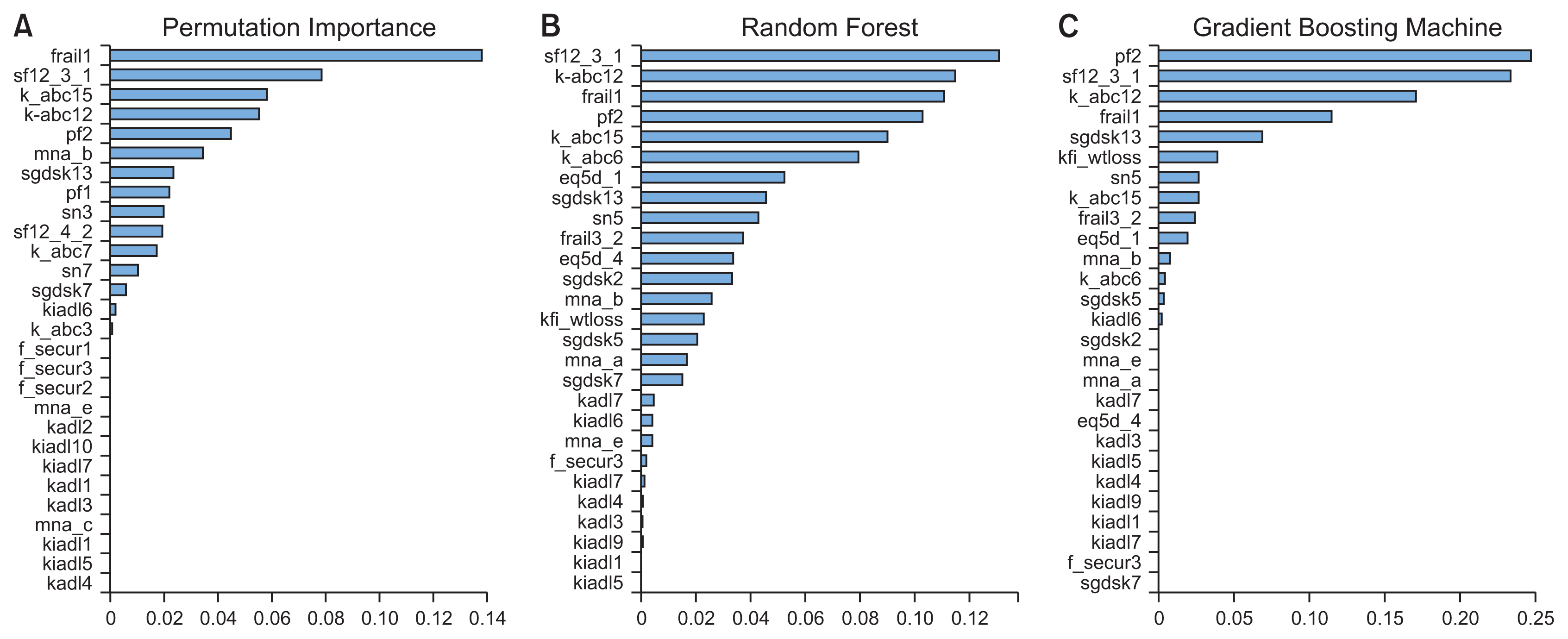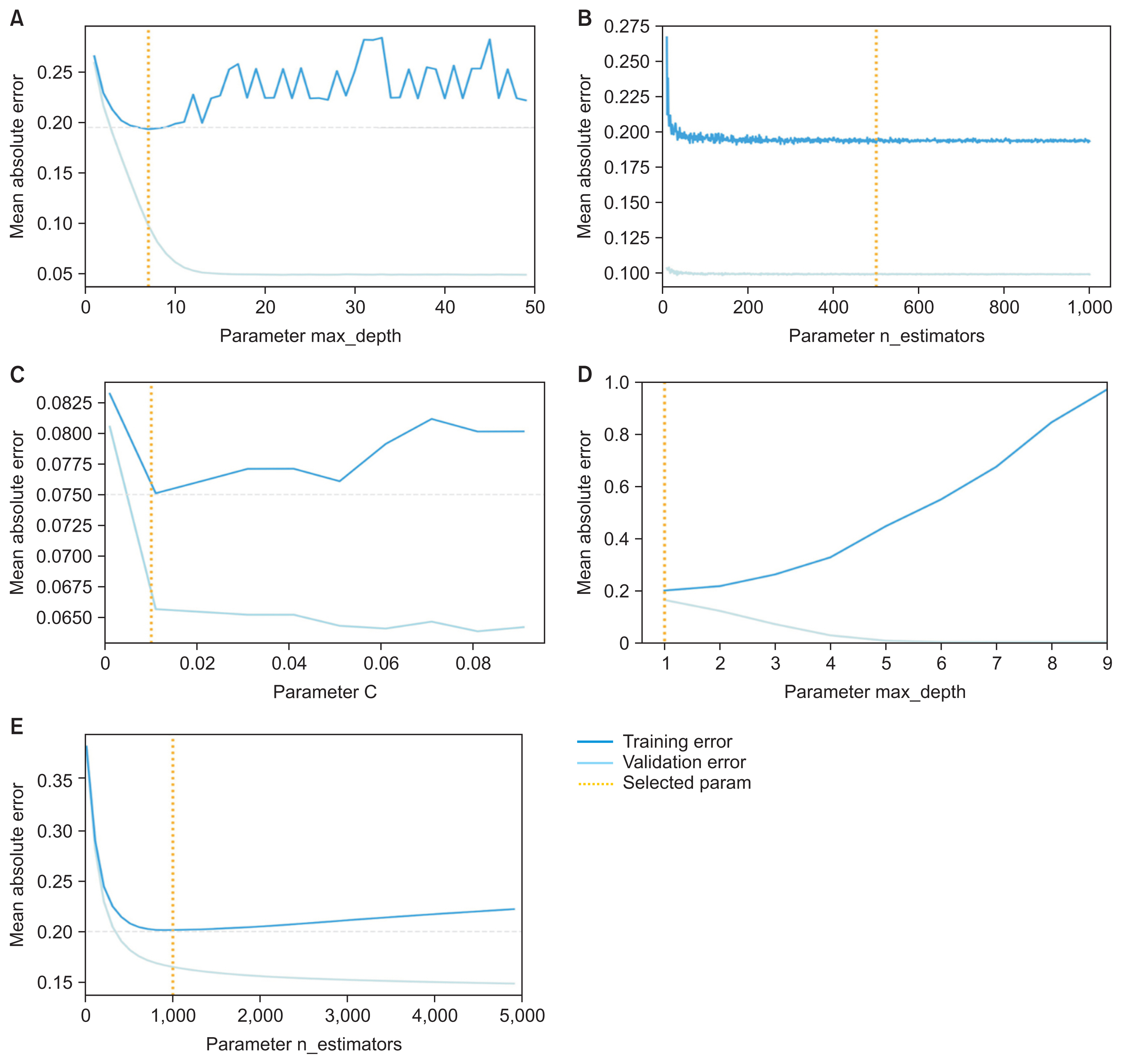Healthc Inform Res.
2022 Jul;28(3):231-239. 10.4258/hir.2022.28.3.231.
Development of a Frailty Detection Model Using Machine Learning with the Korean Frailty and Aging Cohort Study Data
- Affiliations
-
- 1School of Computer Science & Engineering, College of IT Engineering, Kyungpook National University, Daegu, Korea
- 2College of Nursing, Research Institute of Nursing Science, Kyungpook National University, Daegu, Korea
- KMID: 2532450
- DOI: http://doi.org/10.4258/hir.2022.28.3.231
Abstract
Objectives
This paper aimed to use machine learning to identify a new group of factors predicting frailty in the elderly population by utilizing the existing frailty criteria as a basis, as well as to validate the obtained results.
Methods
This study was conducted using data from the Korean Frailty and Aging Cohort Study (KFACS). The KFACS participants were classified as robust or frail based on Fried’s frailty phenotype and excluded if they did not properly answer the questions, resulting in 1,066 robust and 165 frail participants. We then selected influential features through feature selection and trained the model using support vector machine, random forest, and gradient boosting algorithms with the prepared dataset. Due to the imbalanced distribution in the dataset with a low sample size, holdout was applied with stratified 10-fold and cross-validation for estimating the model performance. The reliability of the constructed model was validated using an unseen test set. The model was then trained with hyperparameter optimization.
Results
During the feature selection process, 27 features were identified as meaningful factors for frailty. The model was trained based on the selected features, and the weighted average F1-score reached 95.30% with the random forest algorithm.
Conclusions
The results of the study demonstrated the possibility of adopting machine learning to strengthen existing frailty criteria. As the method analyzes questionnaire responses in a short time, it can support higher volumes of data on participants’ health conditions and alert them regarding potential risks in advance.
Keyword
Figure
Cited by 1 articles
-
Benefits of Information Technology in Healthcare: Artificial Intelligence, Internet of Things, and Personal Health Records
Hyejung Chang, Jae-Young Choi, Jaesun Shim, Mihui Kim, Mona Choi
Healthc Inform Res. 2023;29(4):323-333. doi: 10.4258/hir.2023.29.4.323.
Reference
-
References
1. Organisation for Economic Co-operation and Development (OECD). OECD health statistics 2021 [Internet]. Paris, France: OECD;c2021. [cited at 2021 July 28]. Available from: https://www.oecd.org/health/health-data.htm.2. Lee Y, Kim S, Hwang N, Lim J, Joo B, Namkung EH, et al. 2020 Survey of the living conditions and welfare needs of Korean older persons. Seoul, Korea: Korea Institute for Health and Social Affairs;2021.3. Hajat C, Selwyn A, Harris M, Yach D. Preventive interventions for the second half of life: a systematic review. Am J Health Promot. 2018; 32(4):1122–39.
Article4. Clegg A, Young J, Iliffe S, Rikkert MO, Rockwood K. Frailty in elderly people. Lancet. 2013; 381(9868):752–62.
Article5. Brown PJ, Roose SP, Fieo R, Liu X, Rantanen T, Sneed JR, et al. Frailty and depression in older adults: a high-risk clinical population. Am J Geriatr Psychiatry. 2014; 22(11):1083–95.
Article6. Khandelwal D, Goel A, Kumar U, Gulati V, Narang R, Dey AB. Frailty is associated with longer hospital stay and increased mortality in hospitalized older patients. J Nutr Health Aging. 2012; 16(8):732–5.
Article7. Fried LP, Tangen CM, Walston J, Newman AB, Hirsch C, Gottdiener J, et al. Frailty in older adults: evidence for a phenotype. J Gerontol A Biol Sci Med Sci. 2001; 56(3):M146–56.
Article8. Won CW, Lee Y, Lee S, Kim M. Development of Korean Frailty Index for Primary Care (KFI-PC) and its criterion validity. Ann Geriatr Med Res. 2020; 24(2):125–38.
Article9. Shin J, Kim M, Choi J. Development and Validation of a multidimensional frailty scale for clinical geriatric assessment. J Nutr Health Aging. 2021; 25(7):938–43.
Article10. Won CW, Lee S, Kim J, Chon D, Kim S, Kim CO, et al. Korean frailty and aging cohort study (KFACS): cohort profile. BMJ Open. 2020; 10(4):e035573.
Article11. Pedregosa F, Varoquaux G, Gramfort A, Michel V, Thirion B, Grisel O, et al. Scikit-learn: machine learning in Python. J Mach Learn Res. 2011; 12:2825–30.12. Evgeniou T, Pontil M. Support vector machines: theory and applications. Paliouras G, Karkaletsis V, Spyropoulos CD, editors. Machine learning and its applications: advanced lectures. Berlin, Germany: Springer;2001. p. 249–57.
Article13. Breiman L. Random forests. Mach Learn. 2001; 45(1):5–32.14. Natekin A, Knoll A. Gradient boosting machines, a tutorial. Front Neurorobot. 2013; 7:21.
Article15. Olson RS, Cava WL, Mustahsan Z, Varik A, Moore JH. Data-driven advice for applying machine learning to bioinformatics problems. In : Altman RB, Dunker AK, Hunter L, Ritchie MD, Murray TA, Klein TE, editors. Biocomputing 2018: Proceedings of the Pacific Symposium; 2018 Jan 3–7; Kohala Coast (HI), USA. p. 192–203.16. Kim MH, Cho YS, Uhm WS, Kim S, Bae SC. Cross-cultural adaptation and validation of the Korean version of the EQ-5D in patients with rheumatic diseases. Qual Life Res. 2005; 14(5):1401–6.17. Jung HW, Yoo HJ, Park SY, Kim SW, Choi JY, Yoon SJ, Kim CH, Kim KI. The Korean version of the FRAIL scale: clinical feasibility and validity of assessing the frailty status of Korean elderly. Korean J Intern Med. 2016; 31(3):594–600.18. Kim K, Hong SA, Kwon SO, Oh S. Development of food security measures for Korean National Health and Nutrition Examination Survey. Korean J Nutr. 2011; 44(6):551–51.19. Won CW, Kim SY, Cho BR, Sunwoo D, Jung ES. Weighting the items of Korean activities of daily living(K-ADL) scale and its validity. J Korean Geriatr Soc. 2004; 8(4):196–205.20. Kang SJ, Choi SH, Lee BH, Kwon JC, Na DL, Han SH. The reliability and validity of the Korean Instrumental Activities of Daily Living (K-IADL). J Korean Neurol Assoc. 2002; 20(1):8–14.21. Jang SN, Cho SI, Ou SW, Lee ES, Baik HW. The validity and reliability of Korean fall efficacy scale (FES) and activities-specific balance confidence scale (ABC). J Korean Geriatr Soc. 2003; 7(4):255–68.22. Nestle Nutrition Institute. What is the MNA? [Internet]. Vevey, Switzerland: Nestle Nutrition Institute;c2020. [cited at 2022 Jul 28]. Available from: https://www.mnaelderly.com.23. Lee KJ, Han GS, Yoon SJ, Lee YK, Kim CH, Kim JL, et al. The development of physical functioning scale for community-dwelling older persons. J Prev Med Public Health. 2002; 35(4):359–74.24. Kim SH, Jo MW, Ahn J, Ock M, Shin S, Park J. Assessment of psychometric properties of the Korean SF-12 v2 in the general population. BMC Public Health. 2014; 14:1086.
Article25. Bae JN, Cho MJ. Development of the Korean version of the Geriatric Depression Scale and its short form among elderly psychiatric patients. J Psychosom Res. 2004; 57(3):297–305.
Article
- Full Text Links
- Actions
-
Cited
- CITED
-
- Close
- Share
- Similar articles
-
- Frailty and Biological Age
- Social Frailty
- Discrepancies in the Prevalence of Known Frailty Scales: Korean Frailty and Aging Cohort Study
- Prevalence of New Frailty at Hospital Discharge in Severe COVID-19 Survivors and Its Associated Factors
- Social Frailty Among Community-Dwelling Older Adults: Recommended Assessments and Implications




